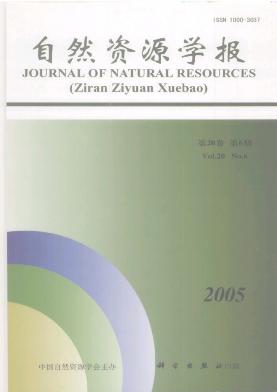Special Column:Celebration of the 70th Anniversary of IGSNRR, CAS
ZHU Hong-yun, YANG Gui-shan, WAN Rong-rong, MA Rong-hua, DUAN Xue-jun
As a land/water ecotone,waterfront of rivers is not only an important part of land re-sources with multifunction,such as port,water supply,recreation,landscape,urban image,biodiver-sity conservation,etc.,but also significant in protecting environment,so it is necessary to rationally exploit and utilize waterfront of rivers.The rational distribution of ports is the principal task because it can degrade environment more violently than other functions of waterfront.Taking the waterfront resources along the Yangtze River mainstream in Nanjing as an example,based on scientific and reasonable division of reverbank cell and evaluation index system with two primary evaluating factors such as stability of waterfront and water depth within 100 m from 0 m isobath,this paper,starting with the demands of ports distribution for waterfront resource condition,firstly evaluates waterfront resource condition and divides them into three grades.The first waterfront is steady or scoured slightly but not deposited with a water depth under 8 m,the expansive water route width and water-behind land width satisfied the need of the ships with a tonnage of ten thousand tons or more.The second waterfront is scoured or deposited slightly with a water depth of 5-8m,the expansive water route width and water-behind land width satisfied the need of the ships with a tonnage of one thousand tons or more.The third waterfront is scoured or deposited violently with a water depth above 5m,incommodious water route width or water-behind land width only satisfied the need of the ships with a tonnage of les than one thousand tons.Secondly,according to the extent of the significane of the waterfront functions and the magnitude of eco-sensitivity of waterfront resources to the distribution of ports,this paper classifies the waterfront resources into three different types;(1)the waterfront sensitive region,including waterfront from 500m upward from the water intake to 500 m downward from the water intake,the biodiversity waterfront,the waterfront for the use of controlling stability of river regime,the waterfront being located in the city and the landscape waterfront;(2)the waterfront less sensitive region,including waterfront within 0.5-2.5 km upward from the water intake,waterfront within 0.5-2.5 km downward from the water intake and 2 km waterfront upward from the biodiversity waterfront,2km waterfront downward from the biodiversity waterfront;(3)the waterfront non-sensitive region,including else waterfront.Finally,on the basis of taking waterfront resources condition and sensitivity of waterfront into account and giving priority to ecological protection,this paper puts forward orientation of distributing ports in waterfront of the Yangtze River mainstream in Nanjing,and the waterfront resources are classified into four kinds;(1)the waterfront for the use of preferential distribution of ports,which is the first grade or the second grade,non-sensitive region;(2)the waterfront for the use of conditional distribution of ports,which is the first grade or the second grade,less sensitive region;(3)waterfront for the use of potential distribution of ports,which is the third grade,non-sensitive region:and(4)the waterfront for the use of inhibitive dis-tribution of ports,which comprises both the third grade,less sensitive region and the sensitive region.
